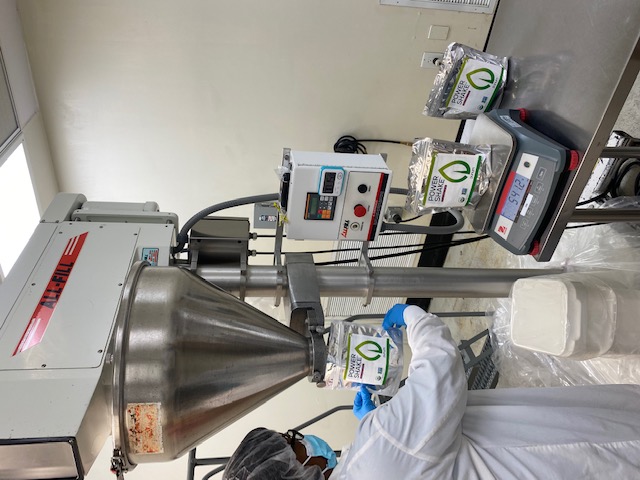The Home of Purium Manufacturing
Manufacturing a Purium Product begins weeks, months and sometimes even years before the product is sold.
Take a peek behind the scenes with this grand outline of the Purium Manufacturing plant process.
- Research & Development – what problem do we want to solve with a superfood formulation
- Define the specifications and pass to supply chain
- Supply Chain locates suppliers and assesses supplier quality & practices before Purium will commit to purchasing in the areas of the following:
- Farming
- Processing
- Labor
- Certifications
- Additional criteria when needed
- Once the supplier is approved, the material is qualified through
- Lab tests
- Organoleptics (visual, taste, smell)
- Document Review
- Once all the documentation and review is in order and approved, it’s time to make a forecast.
- Some materials take months and / or seasons to forecast
- Our materials come from the earth and can take time to grow
- Forecasting is essential to ensure we do not run out of stock at the same time don’t over purchase.
- Supply chain works with suppliers to get the freshest material, just in time for production.

- We have thousands of items in our system and thankfully we have powerful software that helps us manage these material’s stock level and manufacturing requirements.
- Purium installed a new SQL based ERP (enterprise resource planning) system in January 2022. It was a multiple 6 figure investment to meet our manufacturing needs as we grow.
- The formulas for all the products are stored in the ERP system and called Bills of Material (BOM).
- Think of them as master recipes set up to make 1 unit.
- When it is time to manufacture a batch of products, a work order is issued. This copies the BOM and multiplies it by the number of items we are making.
- The ERP system checks inventory on hand that is not committed to other jobs and returns a list of what is lacking
- Purchase orders are prepared and sent to approved suppliers to order the materials that are needed
- Materials are tracked and managed as they make their way to Purium
- Truck arrives with the item
- Inbound truck inspection documented prior to unloading materials
- Product physically inspected and counted / weighed
- Certification status is verified where applicable
- Receive the item in the ERP system under Quarantine
- Sample the item based on the approved statistical sampling model.
- Most items are the square root of n +1
- Physically tag the items with QUARANTINE labeling / signage and send the sample to the lab for testing.
- Each lot of material per delivery has the following tests performed before the material can be released from Quarantine and used in production.
- Microbiological organisms
- Pathogenic organisms
- Identity (to ensure the item is what it claims to be and detect any economic adulteration)
- Organoleptics
- Supplier Certificate of Analysis review of specifications
- Once all tests performed and material is meeting specifications, it can be released. The release process is controlled and can only be initiated by Quality Control personnel.
- Any non conforming materials are returned to the supplier or destroyed.
- Released tags are placed on the materials and they are moved to the main storage area of the warehouse.
- Each item has an item number and lot number. Identification of materials is based on two pieces of information vs one as a control point to ensure the proper item is located.
- Redundancy is a quality control practice built into many processes to prevent human errors.
- The warehouse is full of pallet racks with bin locations
- Each material has a primary bin location and the ERP system tracks where each material is located at all times.
- We maximize our storage capacity by utilizing vertical space with 20 ft pallet racks.
- The upper levels are accessed by stand up forklifts
- When a work order is ready to be produced a list of the needed components is released to the floor along with a batch record. This contains all the ingredients, amounts and instructions on how to produce the product.
- Our material handling staff retrieves the materials utilizing a FIFO (first in first out) inventory practice to maximizing freshness and rotation of stock.
- These materials are physically checked by the material handler as well as verified through the 2 piece identification system (item number and lot number) in the ERP system
- Each material is taken into a weighing room, one at a time, to avoid cross contamination and weighed out to the required amount.
- The materials are labeled and await blending
- Once all materials have been accounted for and verified, they are added one by one to the blender. The blending room and equipment has been given line clearance by QA personnel and the equipment has been swabbed for protein residue (an allergen and cleanliness indicator)
- We have 3 blenders that can be used depending on the size of the blend. Blends can be anywhere from 100 lbs, to 500 lbs to 1000 lbs. Per batch.
- Blend times vary depending on the formula and number of ingredients. Once the material has become homogenized (thoroughly mixed), it is discharged from the blender, bagged and labeled for the next stage of production.
- Powdered products are filled into terra pouches and sealed. We have 3 sets of powder filling equipment which allows for multiple jobs to be running at the same time in separate rooms. This prevents cross contamination between formulas.
- Before each job and use of equipment, a QC line clearance is performed and the equipment is swabbed ensure a clean food contact surface.
- During the filling of the terra pouches samples are verified every 15 minutes to ensure a uniform and properly filled product is being produced. These inspections are documented and signed for as part of the batch record.
- QA personnel inspect additional samples throughout the job.
- Every finished good has a lot number. This number is unique and allows a full track and trace of every material that went into the product as well as every customer that it has been shipped to.
- Each batch of product is randomly sampled and those samples are taken to the lab where more testing is performed. The batch of products is placed on hold pending the review and results.
- Gluten
- Microbiological testing
- Organoleptics
- Composition / strength
- Weight verification
- Once all specifications are met and the batch record is completed, the finished products are released by Quality control personnel for shipping.
Purium is proud to be certified organic, kosher, Non-GMO Program certified and follow Good Manufacturing Practices as established under CFR 111 and 117 and the NSF. Learn more here in our Kosher and Gluten Free Certifications blog.
Purium’s manufacturing takes place within a quality system that includes hundreds of pages of standard operating procedures, thousands of training hours the care of a company who upholds quality as their highest standard.
We maintain various programs that require documentation and accountability every step of the way to ensure quality and integrity in our processes and products.
- Supplier Qualification Program
- Allergen Program
- Calibration Program
- Sanitation Program
- Maintenance Program
- Training Program
- Organic Systems Plan
- Change Control Program
- Research & Development
When you consume a Purium product or give it to a loved one, you can rest assured that it has been formulated and manufactured with the utmost care and adherence to quality.
Please visit our certifications blog as well as our certificate of analysis blog for additional information.



